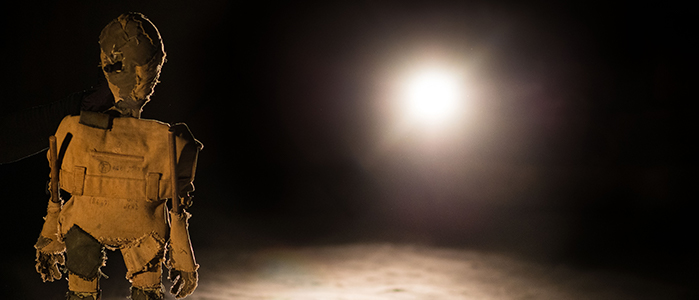Salt of the Earth: Peril and Puppets
This blog post is by Chelsey McLaughlin, a senior theatre major.

Puppet Cinema photo by Yair Meyuhas
The stage: black. The curtains: black. From the left wing of the stage appears puppeteer Zvi Sahar. He approaches the center stage dressed in what we call in the field of puppetry “full blacks” (long sleeve black shirt, long black trousers and black shoes). He carries in his hands a large, white bucket he has retrieved from the perimeter of the stage. From center stage he pauses briefly, then begins to pour. From the bucket streams a procession of white crystals: salt. As his vessel empties, another figure approaches with their white bucket making what is now a small mound. As that figure exits another enters, this time faster. With this latest contribution, the mound now forms a mountain of white. The result is 1,000 pounds of salt. What started as a slow and concentrated effort has now transformed into a rhythmic procession of more and more pouring. These figures are choreographed to drums pulsing to the rhythm of ancient tradition, building with vigor and hurried importance to suggest an approaching peril. As the grains paint the black floor one by one, the audience is transported into an ancient desert landscape firmly disassociated from their own lives. They are now rooted in a new reality — a mission — make it to Ein Harod.
What makes Salt of the Earth different and by far the most extraordinary of puppetry shows I have seen is its incorporation of cameras and live feed video into the puppetry show. Operating the protagonist, a faceless brown Japanese Bunraku-style puppet, the puppeteers partake in the story using their movements and gestures to deepen the clarity of the piece’s intent. They lend voices and bodies to reenactments of the protagonist’s memories of his long, arduous journey which becomes the audience’s journey via the screen.
The creator of this piece, based on the novel The Road to Ein Harod by Amos Kenan, is my teacher and founder of the company PuppetCinema, Zvi Sahar. Z, as he is affectionately known by his students, insists that the biggest benefit of adding cinematography to puppetry is that, “You get the classic magic of puppetry, but also the added element of illusion with this split story told both onscreen and onstage.” The utilization of simple objects found in the average household transform the space in Salt of the Earth; tiny pieces of cardboard are a door, a wall, or a small city. Salt of the Earth allows the audience to appreciate the minutiae of texture, shape, and color up close and from every angle.
